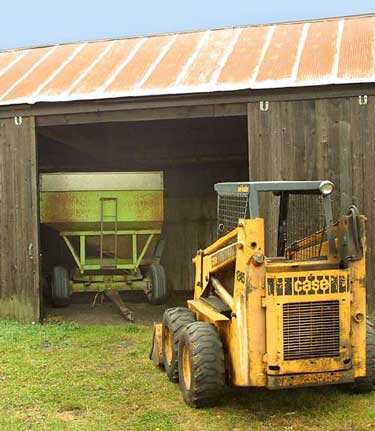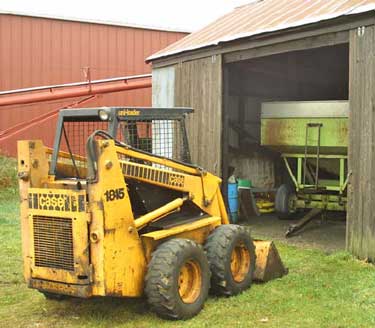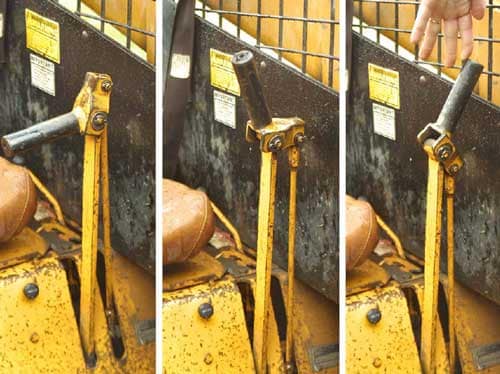Farmer Crushed in Machine Shed Doorway While Using Skid-Steer Loader
Iowa Case Report: 03IA060
Report Date: March 17, 2004
Revised: August 18, 2007
Summary
During the fall of 2003, a 67-year-old farmer was killed while operating a skid-steer loader on his farm. He was using the loader to park gravity flow wagons in a machine shed for winter storage. His method was to catch the tongue of the wagon with the edge of the loader bucket and carefully back the wagons into the shed.
This was a routine task each fall, however, this time the farmer was fatally injured. He was found lying in the raised bucket, facing the rear of the machine, pinned against the header of the doorway shown in Photo 1. Besides crush injuries from the door frame, he also had a broken left ankle, which may not be consistent with this incident but may be from a separate injury event.
He was working alone and the circumstances at the time are not known. It appears he reached for the loader controls while standing in front of the machine. The lift arm control was activated, and the hydraulic lift arm valve or its control mechanism stuck and did not return to the neutral position, forcing the bucket upward until it met the header in the doorway.
All loader movements were controlled by two hand controls, which during our investigation showed considerable wear and tended to stick. For example, if pushed to the extreme, the bucket (right hand) control handle would stick in the up position with the engine not running. However, the lift arm (left hand) control handle did not stick in the up position during this inspection with the engine off. The farmer was found crushed up against the header by his wife, who tried unsuccessfully to start the machine, then called 911. When rescuers arrived, they were able to start the machine and lower the bucket and the victim to the ground, although the design of the controls should have allowed the lift arms to be lowered while the engine was not running.
 |
|
Photo 1 – View of the skid-steer loader, grain wagon, and machine shed (loader backed up six feet).
|
Recommendations based on our investigation are as follows:
- Farm equipment should be maintained in good operating condition.
- Skid-steer loaders should be operated only when sitting in the operator’s seat.
- Manufacturers should always provide reliable mechanisms locking hydraulic controls when the operator is not sitting in the seat.
- Skid-steer loaders should not be used for moving wagons unless appropriate hitching devices are provided.
Introduction
During the fall of 2003, a 67-year-old Iowa farmer was killed while working with his skid-steer loader. The Iowa FACE program was notified of the event a few days later and began an investigation. Information was gathered from newspapers, the county Sheriff’s office, and a mechanic who was familiar with this loader. Contact was made with the victim’s wife and a site visit was scheduled for later that fall. Two Iowa FACE investigators met with her and photographed the loader still in position near the doorway to the machine shed.
The victim had farmed at this 160-acre farm property since 1966, growing corn and soybeans. He rented an additional 240 acres of land, and also raised a few head of cattle. He occasionally received help from his wife, but he was working alone on the day of his death.
There was no safety program in place at this small farm, and there were no outside employees. The farmer was very familiar with machinery and had owned this skid-steer loader for the past 14 years.
Investigation
The incident occurred after harvest on a family farm in northern Iowa. The farmer had just finished combining corn the night before and was putting away his grain wagons for the season. He had six gravity flow wagons, which were stored in machine sheds on the farmstead. Two wagons were stored in a small older shed with sliding wooden doors (see Photo 2). The farmer was working alone that afternoon, and was using the skid-steer loader for final positioning of the wagons into his sheds, for the loader was smaller and easier to maneuver in tight spaces than his tractor. This had been a routine procedure at the farm after harvest.
At the time of the incident, the skid-steer loader was approximately in the same position as shown in Photo 2, only 6 feet (1.8 m) more forward, with the bucket in front of the wagon in the doorway. Normally, the farmer would insert the front edge of the bucket inside the tongue hitch, raise the tongue a bit, then push and steer the wagon into position. The wagon tongue had the hitch pin in place, which suggests that he had backed up the wagon in this location with the tractor. He may have exited the loader to remove the pin before moving the wagon with the loader.
 |
|
Photo 2 – Another view of the skid-steer loader, grain wagon, and machine shed.
|
There were no eyewitnesses to this incident, and the exact circumstances are not known. It’s evident that the farmer had stepped out of the loader while it was running, and the bucket was down. For some reason, he must have reached to the controls to move the loader or re-position the bucket. The hydraulic controls or valves malfunctioned and did not return to a neutral position, and the lift arms continued to rise until the bucket hit the door frame.
The victim had a compound fracture of the left ankle, which may not be consistent with this injury event. It may have occurred beforehand from blunt force, such as being pushed or struck by the moving bucket. In some cases operators may attempt to move the machine while standing on the ground or riding in the bucket, but its unknown whether that occurred in this case. Another possibility is that due to the loader lift arm geometry, the bucket may have come close to the gravity box midway on its way up, and crushed the victim’s leg between the bucket and the gravity box or its ladder. We did not observe signs of this on the gravity box, but cannot rule this out.
This skid steer loader did not have any foot pedals, but all movements were controlled by compound hand controls. Moving the control lever forward and backward controlled the wheels, while up and down motion of the hand levers controlled up and down movements of the lift arms and the bucket.
 |
|
Photo 3 – Three images of the left hand control. The control handle stuck in the DOWN position (left) , the handle in neutral (center), and the handle held in the UP position (right).
|
Photo 3 shows the hand control for the left side wheels and the lift arm height. The left image shows the control stuck in the down position, the middle image shows the control in neutral position, and the right side image shows the control in the up position. The hand controls are designed to return back to the neutral position by centering springs inside the machine. During our investigation we noticed that the controls had significant wear. Due to this wear and/or the weak centering springs, the lift arm lever easily stuck in the down position, as shown on the left image. The machine was not operable at the time of our investigation, and it wasn’t clear if the hand controls or the hydraulic valves were also sticking when activated, with the engine running. One of these malfunctions was necessary for this incident to occur, for the bucket continued rising, even when the victim was not in the operator’s seat.
It’s not clear how the farmer initially activated the hand controls. Perhaps he attempted to move the loader while standing on the ground, however, his wife had never seen him do this. He could have lost his balance when entering the loader, and accidentally hit the raise lever. In any case, the control or the valve raising the lift arms became stuck and continued to raise the lift arms crushing the farmer in the bucket up against the doorway header. His feet were inside the shed, and his arms pointed toward the rear of the loader. The loader stalled in this position, for the machine was not running when the man was found by his wife. She tried unsuccessfully to start the loader, then went to the house and called for rescue. Firemen were able to start the machine, lower the bucket, then back away from the building to the position seen in Photos 1 and 3. As designed, the lift arms could have been lowered with the engine off by actuating the left hand control but for unknown reasons neither the wife nor the rescuers did so. The man was dead at the scene from asphyxiation.
The skid-steer loader was a Case Model 1845, manufactured in 1977, and bought used in 1989. It did not have any electrical or mechanical interlocks built-in, but did include a seatbelt. This skid-steer loader was involved in a machine fire 2-3 years ago, the fire starting under the right rear portion of the seat, sparked from a worn battery wire to the ignition. Apparently due to machine vibration, this wire had worked loose, worn through and shorted out causing the fire, which quickly spread underneath the machine due to an accumulation of dry corn stalk debris. The machine was repaired following this fire. It is possible that the fire damaged the linkages, or weakened the left centering spring for the hand control linkage, making it unable to return the lever back to a neutral position.
At the time of the investigation, the machine had an obvious engine oil leak from the oil filter area. A repair appeared to be underway, with some parts, bolts and nuts removed. Apparently the machine had leaked oil over time, as the surfaces in this area had a buildup of oil and dust. It is not clear when the major oil leak occurred, but it was apparently after the incident and was not a factor in this injury.
Cause of Death
The cause of death as taken from the Medical Examiner’s report was, massive crush injuries to chest and back. Both left leg bones had open fractures at the ankle.
Recommendations/Discussion
Recommendation #1 Farm equipment should be maintained in good operating condition.
Discussion: The older skid-steer loader had wear from previous use. The control linkages
were worn, and in need of adjustment and repair. The left side control for the lift arms had a weak centering spring, and the control did not return to the neutral position as designed. After it was activated, the loader kept rising, which could have been caused by a sticky linkage or hydraulic valve. The centering spring is a very important safety feature in the controls, and should be maintained in operable condition.
Recommendation #2 Skid-steer loaders should be operated only when sitting in the operator’s seat.
Discussion: Many skid-steer loader fatalities have occurred when the operator attempts to
control the machine while standing in the bucket or on the ground. This unsafe practice may be very tempting when there is a need to frequently step out of the machine, for instance to open and close gates while feeding animals. Newer machines have interlocks that prevent operating the loader in this way, unless the interlocks are deliberately disabled or bypassed. However, operating the loader from outside the operator’s station is dangerous and should not be done under any circumstances. Loader models with hand controls for both wheel and bucket movements are easier to operate from outside the loader than those with both hand and foot controls. There is no evidence that the victim in this case was using the loader in this manner, but it is one possible cause for similar incidents.
Recommendation #3 Manufacturers should always provide reliable mechanisms locking hydraulic controls when the operator is not sitting in the seat.
Discussion: Various types of safety interlocks have been designed to prevent injuries from
unintentional movements of skid-steer loaders when the operator is not sitting in the seat, and does not have full access to machine controls. Interlocks began appearing on new skid-steer loaders in the early 1980’s, and great improvements have been made since then. This older machine did not have safety interlocks; and it would be very difficult to retrofit, therefore, the only safe option may be to recycle the machine. Most older machines, however, are kept running regardless of safety features, therefore, owners are encouraged to exercise extra caution while using these machines, mindful of the inherent increased risk of injury and death from the absence of functional interlock mechanisms.
Fatalities most commonly occur when the victim is pinned under the bucket when it comes down unintentionally. In this more rare case the victim was pinned on top of the bucket, crushed against a door frame. While it’s unclear how this happened, it’s obvious that active interlock mechanisms would have prevented this injury, for interlocks prevent hydraulic movements whenever the operator is not in the operator station.
Recommendation #4 Skid-steer loaders should not be used for moving wagons unless appropriate hitching devices are provided.
Discussion: Skid-steer loaders are very handy for a wide variety of tasks, and some farmers have used them to move wagons, as in this case. The loader is able to go in spaces where the larger tractor is not. The loader will also make turning the wagon tongue easier, when the wagon needs to be parked in a tight space. The problem with this practice is that the loader bucket is not designed to be used for hitching towed implements. The wagon tongue may slide and fall out from the edge of the bucket. This practice should be avoided unless proper hitching devices are provided on the loader.
May 1, 2007 revision to clarify the float position for and the function of left (lift arm) control when the engine is not running resulted in changes primarily to the second paragraph of the “SUMMARY”, to the text describing Photo 3, and to the third from last paragraph of the “INVESTIGATION” section.
Iowa FACE Program
FACE is an occupational fatality investigation and surveillance program of the National Institute for Occupational Safety and Health (NIOSH). In the state of Iowa, The University of Iowa, in conjunction with the Iowa Department of Public Health carries out the FACE program. The NIOSH head office in Morgantown, West Virginia, carries out an intramural FACE program and funds state based programs in Alaska, California, Iowa, Kentucky, Massachusetts, Michigan, Minnesota, Nebraska, New Jersey, New York, Oklahoma, Oregon, Washington, West Virginia, and Wisconsin.
The purpose of FACE is to identify all occupational fatalities in the participating states, conduct indepth investigations on specific types of fatalities, and make recommendations regarding prevention. NIOSH collects this information nationally and publishes reports and Alerts, which are disseminated widely to the involved industries. NIOSH FACE publications are available from the NIOSH Distribution Center (1-800-35NIOSH).
Iowa FACE publishes case reports, one page Warnings, and articles in trade journals. Most of this information is posted on our web site listed below. Copies of the reports and Warnings are available by contacting our offices in Iowa City, IA.
The Iowa FACE team consists of the following from the University of Iowa: Craig Zwerling, MD, PhD, MPH, Principal Investigator; Wayne Johnson, MD, Chief Investigator; John Lundell, MA, Coordinator; Risto Rautiainen, PhD, Co-Investigator, Martin L. Jones, PhD, CIH, CSP, Co-Investigator, and John Kraemer, PA. From the Office of The State Medical Examiner.
To contact Iowa State FACE program personnel regarding State-based FACE reports, please use information listed on the Contact Sheet on the NIOSH FACE web site Please contact In-house FACE program personnel regarding In-house FACE reports and to gain assistance when State-FACE program personnel cannot be reached.

